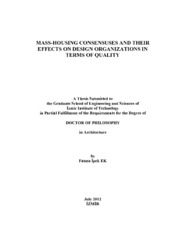Please use this identifier to cite or link to this item:
https://hdl.handle.net/11147/2931Full metadata record
| DC Field | Value | Language |
|---|---|---|
| dc.contributor.advisor | Çıkış, Şeniz | en |
| dc.contributor.author | Ek, Fatma İpek | - |
| dc.date.accessioned | 2014-07-22T13:48:37Z | - |
| dc.date.available | 2014-07-22T13:48:37Z | - |
| dc.date.issued | 2012 | en |
| dc.identifier.uri | http://hdl.handle.net/11147/2931 | - |
| dc.description | Thesis (Doctoral) -- İzmir Institute of Technology, Architecture, İzmir, 2012 | en |
| dc.description | Includes bibliographical references (laves: 235-248) | en |
| dc.description | Text in English; Abstract: Turkish and English | en |
| dc.description | xxv, 268 leaves | en |
| dc.description | Full text release delayed at author's request until 2015.07.16 | en |
| dc.description.abstract | There is an increasing acceleration in the production of mass-housing projects currently in Turkey. Alongside this increase, there is conspicuous diversity, as well. In most of the recent mass-housing projects, there are many alternatives concerning with the locations in the city, income groups, and characteristics of environmental design. Settlements of those projects with multi-storey blocks contain facilities in outer spaces, equipments, and services which vary according to the conditions of parcels and competition as well as inhabitants’ expectations. Despite this variety in environmental equipments, landscape elements, and services, mass-housing units mostly repeat each other impressively. Almost all of the mass-housing projects implemented recently for low or high income-groups, in the periphery of the city-center, go into uniformity in terms of the spatial organizations of units. This situation has been criticized frequently in the related housing-literature which defines it as a quality problem of architecture. In the current study examining the situation of uniformity in mass-housing units, relationship between the unit and quality of architectural design is undertaken. In this context, how the inhabitants perceive the spatial organization of mass-housing projects, and whether those units meet the expectations are probed. Regarding this aim, userbased quality approaches and measurement method called the Kano model are utilized. Thus, the study covers the examination of the selected mass-housing units in terms of their models of spatial organization with the evaluations by their inhabitants. Under the light of the survey results, whether this uniformity refers a problem or a consensus is discussed. | en |
| dc.language.iso | en | en_US |
| dc.publisher | Izmir Institute of Technology | en_US |
| dc.rights | info:eu-repo/semantics/openAccess | en_US |
| dc.subject.lcsh | Cluster housing--Turkey | en |
| dc.title | Mass-housing consensuses and their effects on design organizations in terms of quality | en_US |
| dc.type | Doctoral Thesis | en_US |
| dc.authorid | 0000-0002-6783-8284 | en |
| dc.institutionauthor | Ek, Fatma İpek | - |
| dc.department | Thesis (Doctoral)--İzmir Institute of Technology, Architecture | en_US |
| dc.relation.publicationcategory | Tez | en_US |
| item.languageiso639-1 | en | - |
| item.grantfulltext | open | - |
| item.openairetype | Doctoral Thesis | - |
| item.cerifentitytype | Publications | - |
| item.fulltext | With Fulltext | - |
| item.openairecristype | http://purl.org/coar/resource_type/c_18cf | - |
| crisitem.author.dept | 02.02. Department of Architecture | - |
| Appears in Collections: | Phd Degree / Doktora | |
Files in This Item:
| File | Description | Size | Format | |
|---|---|---|---|---|
| 437137.pdf | DoctoralThesis | 18.55 MB | Adobe PDF |  View/Open |
CORE Recommender
Page view(s)
184
checked on Sep 23, 2024
Download(s)
1,168
checked on Sep 23, 2024
Google ScholarTM
Check
Items in GCRIS Repository are protected by copyright, with all rights reserved, unless otherwise indicated.